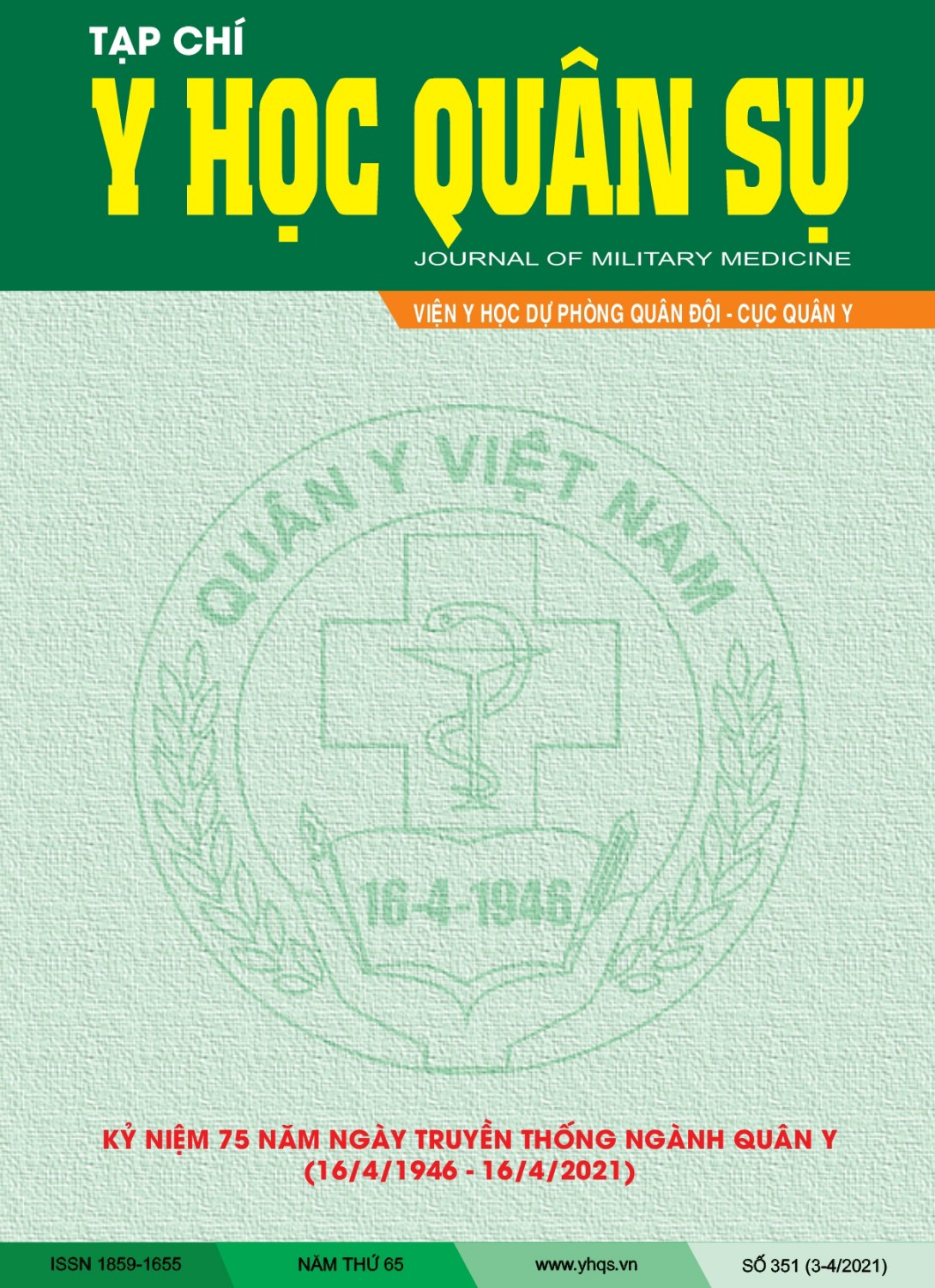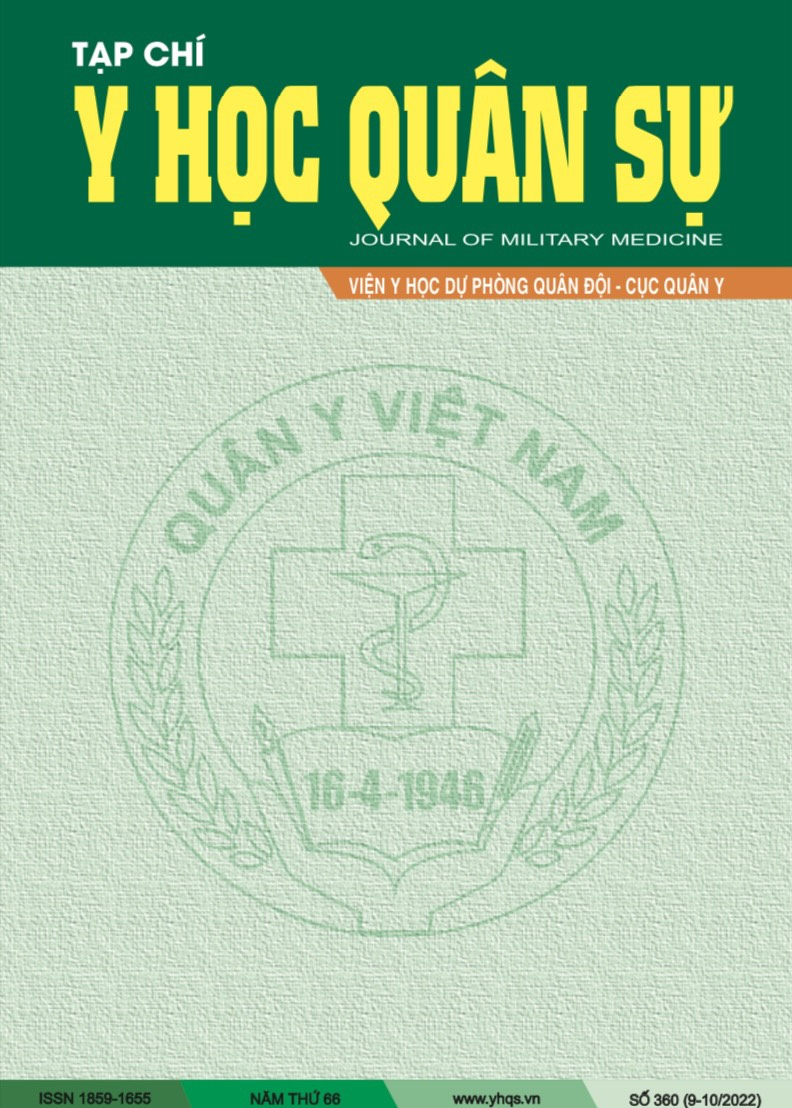MỘT SỐ YẾU TỐ LIÊN QUAN ĐẾN RỐI LOẠN NUỐT Ở NGƯỜI BỆNH ĐỘT QUỴ NÃO CẤP
Từ khóa:
Đột quỵ não, rối loạn nuốt, GUSSTóm tắt
Nghiên cứu mô tả cắt ngang xác định tỉ lệ rối loạn nuốt theo thang điểm GUSS và một số yếu tố liên quan đến rối loạn nuốt ở 73 người bệnh đột quỵ não cấp, điều trị tại Khoa Nội thần kinh, Bệnh viện Quân y 175, từ tháng 02-5/2019. Kết quả: Người bệnh trung bình 62,63 ± 12,9 tuổi; tỉ lệ nam/nữ ≈ 2/1. Đa số người bệnh nhập viện trong khoảng thời gian từ 6-24 giờ sau đột quỵ (34,2%), tình trạng ý thức tỉnh táo (71,2%). 63,0% người bệnh có rối loạn nuốt (mức độ nhẹ: 21,9%; mức độ trung bình: 13,7%; mức độ nặng: 27,4%). Có mối liên quan giữa tỉ lệ rối loạn nuốt sau đột quỵ não với tổn thương não 2 bên và rối loạn ý thức; người bệnh đột quỵ não có tiền sử tăng huyết áp thì nguy cơ rối loạn nuốt cao hơn người bệnh không có tiền sử tăng huyết áp. Người bệnh đột quỵ não có kèm theo từ 1 bệnh trở lên làm tăng nguy cơ rối loạn nuốt. Thang điểm GUSS cung cấp một phương pháp nhanh chóng và đáng tin cậy giúp điều dưỡng xác định người bệnh đột quỵ có rối loạn nuốt tại giường.
Tài liệu tham khảo
1. Bộ Y tế (2018), Hướng dẫn chẩn đoán, điều trị phục hồi chức năng cho NB đột quỵ, tr. 8.
2. Nguyễn Đức Trung, Nguyễn Văn Liệu (2016), “Nghiên cứu rối loạn nuốt ở NB NMN bằng thang điểm Mann và đánh giá các yếu tố liên quan”, Tạp chí Y Dược học Quân sự, tr. 63-68.
3. Nguyễn Thị Phương Nga, Phan Xuân Nam, Trần Kim Phuợng (2014), “Đánh giá rối loạn nuốt ở NB ĐQN cấp bằng thang điểm GUSS”, Tạp chí Y học Thành phố Hồ Chí Minh,18 (3), tr. 47-52.
4. Phan Nhựt Chí, Nguyễn Thị Thu Hương (2011), “Nghiên cứu rối loạn nuốt theo GUSS ở NB ĐQN cấp tại Bệnh viện Cà Mau 2010-2011”, Tạp chí Y học thực hành, 811+812, tr. 189-195.
5. Al-Khaled M, Matthis C, Binder A et al (2016), “Dysphagia in patients with acute ischemic stroke: early dysphagia screening may reduce stroke-re- lated pneumonia and improve stroke outcomes”, Cerebrovasc Dis, 42 (1-2), pp. 81-9.
6. Arnold M, Liesirova K, Broeg-Morvay A et al (2016), “Dysphagia in Acute Stroke: Incidence, Burden and Impact on Clinical Outcome”, PLOS ONE, 11 (2), pp. 1-11.
7. Bakhtiyari J, Sarraf P, Nakhostin-Ansari N et al (2015), “Effects of early intervention of swallow- ing therapy on recovery from dysphagia following stroke”, Iranian Journal of Neurology, 14 (3), pp. 119-124.
8. Boaden E, Doran D, Burnell J et al (2017), “Screening for aspiration risk associated with dys- phagia in acute stroke (Protocol)”, Cochrane Data- base of Systematic Reviews (6).
9. Boulanger J.M, Lindsay M.P, Gubitz G et al (2018), “Canadian stroke best practice recommen- dations for acute stroke management: prehospital, emergency department, and acute inpatient stroke care, 6th Edition, Update 2018”, Int J Stroke, 13 (9),
pp. 949-984.
10. Bray B.D, Smith C.J, Cloud G.C et al (2017), “The association between delays in screening for and assessing dysphagia after acute stroke, and the risk of stroke-associated pneumonia”, J Neurol Neurosurg Psychiatry, 88 (1), pp. 25-30.
11. Cohen D.L, Roffe C, Beavan J et al (2016), “Post-stroke dysphagia: A review and design con- siderations for future trials”, Int J Stroke,11 (4), pp. 399-411.
12. Ferreira AMdS, Pierdevara L, Ventura IM et al (2018), “The Gugging Swallowing Screen: A con- tribution to the cultural and linguistic validation for the Portuguese context”, Revista de Enfermagem Referencia, 4 (16), pp. 85-92.
13. Lopes M, Freitas E, Oliveira M et al (2019), “Impact of the systematic use of the Gugging Swal- lowing Screen in patients with acute ischaemic stroke”, Eur J Neurol, 26 (5), pp. 722-726.
14. Mourão A.M, Almeida E.O, Lemos S.M.A et al (2016), “Evolution of swallowing in post-acute stroke: a descriptive study”, Revista cefac, 18 (2),
pp. 417-425.
15. Teuschl Y, Trapl M, Ratajczak P et al (2018), “Systematic dysphagia screening and dietary mod- ifications to reduce stroke-associated pneumonia rates in a stroke-unit”, PLoS One, 13 (2), pp. 1-16.
16. Samia E.S.B, Safinaz Nagib Azab2, Ra- sha H.S et al (2017), “Assessment of dysphagia in acute stroke patients by the Gugging Swallowing screen”, Glob J Otolaryngol, 9 (4), pp. 1-8.



